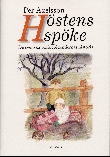Sökning: onr:hsnbr5b1f5l4ccxv > Höstens spöke
- 1 av 1
- Föregående post
- Nästa post
- Till träfflistan
Höstens spöke [Elektronisk resurs] de svenska polioepidemiernas historia
- Axelsson, Per, 1972- (författare)
- Sköld, Peter (preses)
- Vallgårda, Signild (opponent)
- Umeå universitet Humanistiska fakulteten (utgivare)
- Publicerad: Stockholm : Carlsson, 2004
- Svenska 312
- Serie: Report from the Demographic Data Base, 0349-5132 0349-5132
- Bok (digitaliserad)Avhandling(Diss. Umeå : Umeå universitet, 2004)
Sammanfattning
Ämnesord
Inställningar
Hjälp
Stäng
- Polio epidemics appeared in Sweden in 1881 and at the turn of the 20th century the disease became an annual feature in the epidemiological pattern. Due to vaccination starting in 1957 epidemics ceased to exist in Sweden around 1965. This thesis deals with the history polio epidemics in Sweden, 1880-1965 and studies the demographical influence of polio, how the medical authorities investigated and tried to combat it, and the care of those who contracted the disease. A study of polio mortality and incidence in Sweden at the national level during 1905-1962 reveals that the disease caused 6,000 deaths out of the 51,000 cases reported. At the beginning of the 20th century polio primarily attacked children up to 10 years of age. At the end of the period victims were represented in all age groups, but mainly in the ages 15-39. Moreover, a regional incidence study shows considerable regional differences. Sweden and the USA developed different ways of investigating and explaining the causes of polio thinking that led to diverse preventive measures. Moreover, in the 1950’s Sweden developed its own vaccine, different in choice of methods and materials from the widely used Salk-vaccine. When polio was classified as an epidemic in 1905, those infected by polio were usually taken to an isolation hospital. These hospitals were owned and financed by the state. The aftercare of polio victims was organized by philanthropist organizations. Polio was associated with dirt and unhygienic circumstances until the 1950’s when the theory of polio epidemics as a backlash of good hygiene and sanitary standards was established. The theory is built upon the correlation between neonatal mortality and polio incidence. However, correlation analysis at the regional level reveals no significant relationship between these variables. In Sweden, the hygienic movement had been very influential, and this study suggests that the theory quickly was accepted, because it explained why Sweden could be hit by epidemics and still be considered a welfare state with good hygienic and sanitary standards.
Ämnesord
- Humanities and the Arts (ssif)
- History and Archaeology (ssif)
- History (ssif)
- Humaniora och konst (ssif)
- Historia och arkeologi (ssif)
- Historia (ssif)
- HUMANITIES and RELIGION (svep)
- History and philosophy subjects (svep)
- History subjects (svep)
- History of medicine (svep)
- HUMANIORA och RELIGIONSVETENSKAP (svep)
- Historisk-filosofiska ämnen (svep)
- Historieämnen (svep)
- Medicinens historia (svep)
- historia (umu)
- History (umu)
Genre
- government publication (marcgt)
Indexterm och SAB-rubrik
- History of medicine
- polio
- history of medicine
- history of diseases
- demography
- medical science
- preventive measures
- vaccination
- health care
- disability
- therapeutics
- Sweden
- 20th century
- Medicinhistoria
Uppgift om bibliotek saknas i LIBRIS
Kontakta ditt bibliotek, eller sök utanför LIBRIS. Se högermenyn.
- 1 av 1
- Föregående post
- Nästa post
- Till träfflistan
Sök vidare
Hjälp
- Fler titlar av
- Axelsson, Per, 1972-
- Sköld, Peter
- Vallgårda, Signild
- Umeå universitet Hum ...
- Fler titlar om
- Humanities and the A ...
- History and Archaeol ...
- History
- Humaniora och konst
- Historia och arkeolo ...
- Historia
- visa fler...
- HUMANITIES and RELIG ...
- History and philosop ...
- History subjects
- History of medicine
- HUMANIORA och RELIGI ...
- Historisk-filosofisk ...
- Historieämnen
- Medicinens historia
- historia
- visa färre...
- Fler titlar i denna genre
- government publicati ...
- Serie
- Fler delar
- channel record
- Fler delar
Sök utanför LIBRIS
Hjälp
- Sök vidare i:
- Google Book Search
- Google Scholar
- LibraryThing
Kungliga biblioteket hanterar dina personuppgifter i enlighet med EU:s dataskyddsförordning (2018), GDPR. Läs mer om hur det funkar här.
Så här hanterar KB dina uppgifter vid användning av denna tjänst.
Copyright © LIBRIS - Nationella bibliotekssystem

